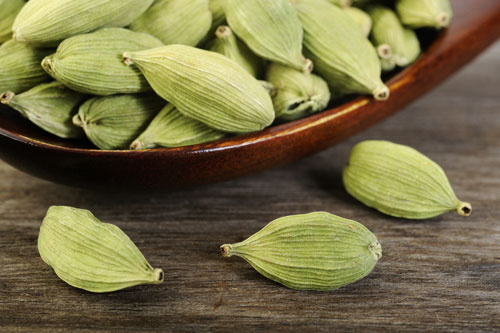There is one kitchen spice most of us could use more of in our lives: cardamom.
While there are different types of cardamom (see end for details), just the plain old spice you have in your kitchen cabinet will do. It is a powerful digestive aid that comes in quite handy, for maintenance or acute distress. But it’s best as a preventative, too.
Cardamom is a very ancient spice. It is the seed of the perennial tropical plant in the ginger (Zingiberaceae) family. In Traditional Chinese Medicine (TCM), it is in the category of herbs called, “aromatic dispel dampness.” This means its aroma plus drying nature help to eliminate dampness in the digestive tract.
Symptoms of dampness include anywhere from a feeling of heaviness or edema to loose stools, diarrhea, poor appetite, nausea, vomiting, acid reflux, abdominal distention, chest fullness or an oppressive sensation in the chest, and lethargy.
Further, when dampness congeals over time it forms phlegm, which in turn creates tumors, cysts, soft lumps, nodules, cancer, numbness, tremors and paralysis.
As well, cardamom alleviates food stagnation, or food that is poorly digested and so congests and collects in the body. This condition may be either acute or chronic. The acute type is similar to the after-effects of over-eating at a holiday meal and can even cause pain in the heart region; the chronic type occurs when digestion becomes impaired and the body can no longer fully digest or absorb nutrients.
When food overwhelms the stomach, it results in such symptoms as sour regurgitation, reflux or vomiting, belching and/or hiccupping, and foul breath, or it passes on to the intestines causing foul gas, loose stool, or foul-smelling diarrhea. The partially digested food then lingers in the body, congesting the organs and channels and slowing the circulation of Qi, Blood and fluids.
Acute food stagnation in the upper part of the body can cause palpitations or stuffiness around the heart and in the epigastric region. Many folks go to emergency care thinking they are having a heart attack, but what they are really experiencing is acute food congestion in the stomach.
In the middle part of the body, acute food stagnation can cause lack of appetite, fullness and distention of the epigastrium relieved by vomiting; insomnia with a full feeling in the stomach region, unrelieved hiccupping, epigastric spasms, nausea, foul breath, sour regurgitation, belching, abdominal fullness, bloating, and poor distribution and/or assimilation of nutrients.
Still wonder if you have dampness? Stick out your tongue in front of a mirror. If it’s swollen and/or has teeth indentations on the sides (called scallops), then you have dampness. If you have a white or yellow coat, that’s also dampness. The thicker and greasier the coat, the more the dampness has turned to food stagnation or phlegm.
So, are you inspired to find a solution?
Use cardamom!
This is the reason I’ve outlined so many symptoms here: cardamom can treat them all and this is one spice to have on hand. It will save you many a discomforting hour and perhaps even a trip to some sort of emergency care.
And yet, cardamom is a great herb to include on a daily basis. Most people include a long list of dampening foods in their diets: iced drinks, cold foods directly from the refrigerator, smoothies, dairy, soy, soy milk, rice milk, oatmeal, cucumbers, flour products (muffins, bagels, bread, pasta, chips, crackers, pastries), excess raw foods, salads, yogurt, ice cream, potatoes, fruit juices, excess fruit in general, specifically bananas, citrus and persimmons – I could go on and on.
TCM uses true cardamom, or sha ren (Amomum villosum, A. xanthiodes, Elettaria villosa, Cardamomum villosum)) for the above symptoms as well as morning sickness and a restless fetus. It is also frequently added to formulas with cloying herbs to aid in their digestion.
Ayurveda also widely uses cardamom. It is given to eliminate mucus and for colds, coughs, bronchitis, hoarseness, asthma, and a loss of the ability to taste.
For those who want all the specifics, here they are:
Cardamom Fruit, Round (Amomum cardamomum, Elettaria cardamomum)
Bai dou kou (Chinese) Family: Zingiberaceae
Also named: cardamom cluster, Amomi Fructus rotundus
Energy and flavors: warm, acrid
Organs and channels affected: Spleen, Stomach, Lung
Chemical constituents: d-camphor, d-borneol
Properties and actions: carminative, stomachic, antiemetic, expectorant; aromatically transforms Dampness, directs Qi downward
Contraindications: Deficient Blood or Yin
Dosage: 3-6g in decoction (added in the last five minutes); 2-5g as a powder; 20-60 drops tincture (1:10 @40%ABV), TID
Cardamom Seed, True (Amomum villosum, A. xanthiodes, Elettaria villosa, Cardamomum villosum)
Sha ren (Chinese) Family: Zingiberaceae
Also named: grains-of-paradise fruit, Amomi Fructus
Energy and flavors: warm, acrid
Organs and channels affected: Spleen, Stomach, Lungs
Chemical constituents: 2-8% volatile oil comprising limonene, terpinene, dipentene, camphor, borneol
Properties and actions: antiemetic, carminative, antidiarrheal, aromatic, stimulant, stomachic, antiemetic; aromatically transforms Dampness, regulates Qi
Contraindications: Deficient Yin with Heat signs.
Dosage: 3-6g; Because of its essential oil content, Cardamom is added in the last five minutes of a decoction; 2-5g as a powder; 30-90 drops tincture (1:10 @40%ABV), TID

